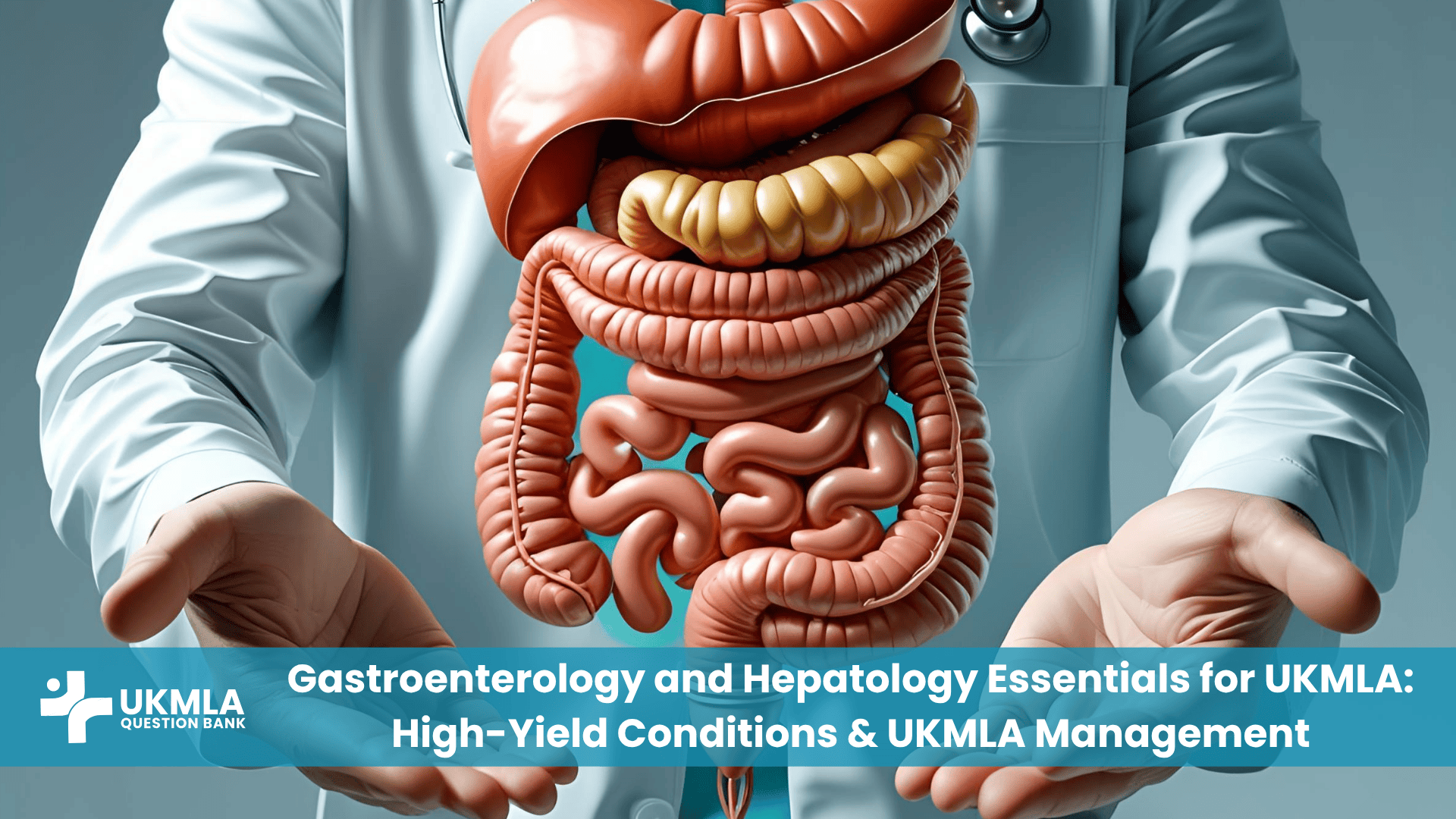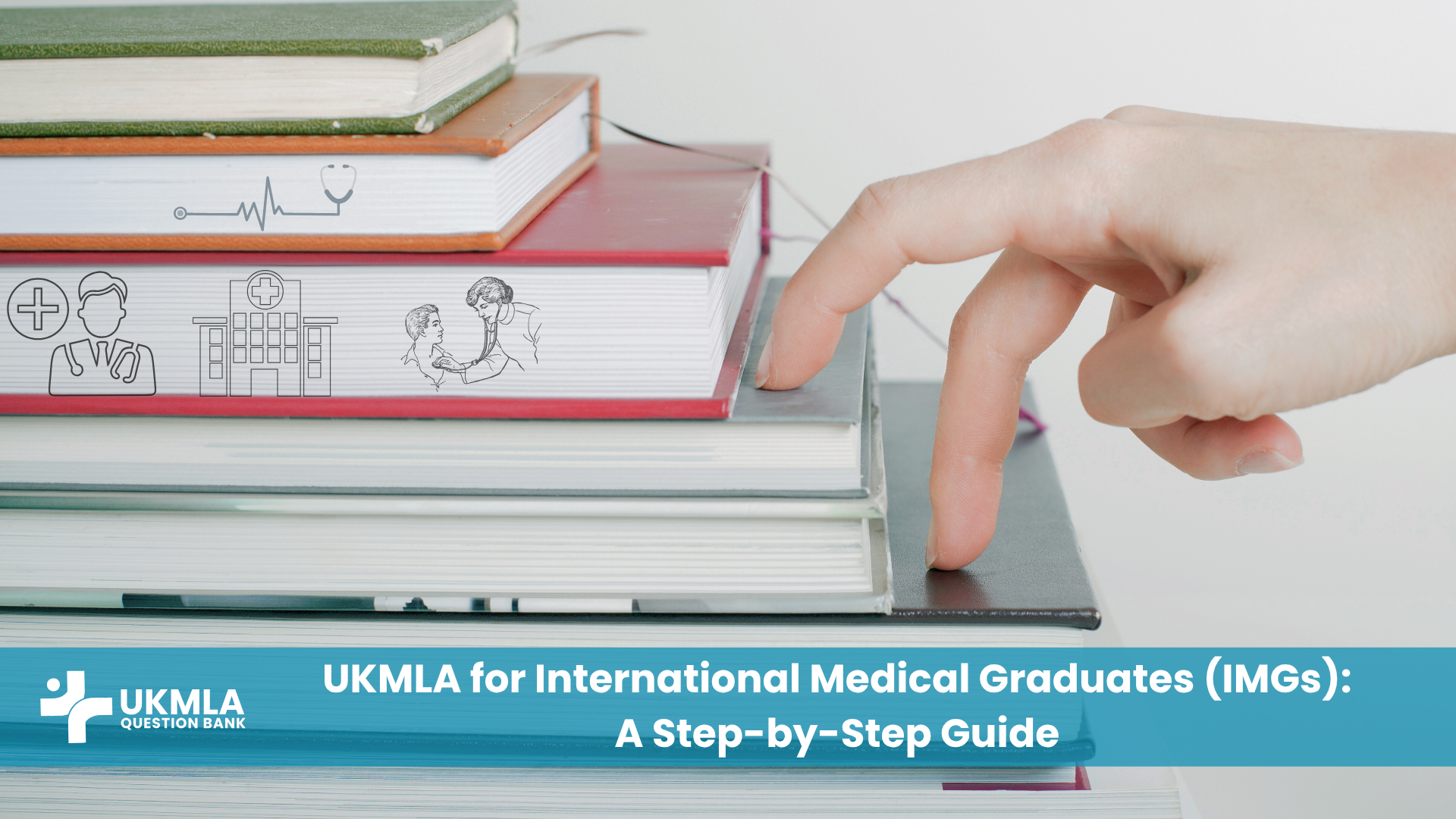Picture this: you’re in the middle of your UKMLA AKT exam, tackling questions on Gastroenterology for the UKMLA, and a question pops up describing a young patient with bloody diarrhoea, abdominal pain, and weight loss. The options include Ulcerative Colitis and Crohn’s disease. Your heart rate quickens. Is the inflammation transmural or just mucosal? Are skip lesions present? Under the pressure of the clock, these crucial differentiating features can blur, turning a question you know into a potential point dropped.
Mastering Gastroenterology for the UKMLA is not about knowing every rare syndrome; it’s about confidently diagnosing and outlining the initial management for the common and the critical presentations you will encounter as a Foundation Year doctor. This guide is designed to cut through the noise and provide a focused, high-yield overview of the essential topics. We will break down the key differences in inflammatory bowel disease, walk through the management of a GI bleed, demystify liver cirrhosis, and clarify the diagnostic pathways for conditions like Coeliac disease and Irritable Bowel Syndrome, all based on current UK guidelines.
Key Takeaways
- Focus on Differentiation: A deep understanding of the key differences between similar conditions, like Crohn’s disease and Ulcerative Colitis, is essential for answering UKMLA questions correctly.
- Recognise Emergencies: You must be able to identify and outline the initial ‘ABCDE’ management for life-threatening conditions, particularly Upper GI Bleeding.
- Master Diagnostic Pathways: For conditions like Coeliac disease and IBS, knowing the correct sequence of investigations and diagnostic criteria is a frequently tested, high-yield concept.
- Anchor in UK Guidelines: Your knowledge must be rooted in the standard approach in UK practice. Referencing bodies like NICE and the British Society of Gastroenterology (BSG) is key to your preparation.
- Think Like a Foundation Doctor: The UKMLA assesses your readiness for safe practice. Your focus should be on initial assessment, investigation, and management of common and critical conditions.
1. Inflammatory Bowel Disease (IBD): A Core Topic in Gastroenterology for UKMLA
Inflammatory Bowel Disease is a cornerstone of any medical curriculum and a guaranteed topic on the exam. The primary challenge lies in distinguishing between its two main forms: Crohn’s Disease (CD) and Ulcerative Colitis (UC). While both present with diarrhoea, pain, and systemic symptoms, their pathology and clinical course differ significantly.
Crohn’s vs. Ulcerative Colitis: A Head-to-Head Comparison
Understanding the fundamental differences is non-negotiable. Examiners will often provide clues in the history (smoking status), examination findings (perianal disease), or investigation results (endoscopy findings) that point towards one diagnosis over the other.
Table 1: Key Differentiating Features of Crohn’s Disease vs. Ulcerative Colitis
| Feature | Crohn’s Disease | Ulcerative Colitis |
|---|---|---|
| Site of Inflammation | Mouth to anus (“gum to bum”), commonly terminal ileum. | Rectum, extending proximally in a continuous fashion. |
| Pattern | Skip lesions (healthy tissue between inflamed areas). | Continuous inflammation. |
| Depth of Inflammation | Transmural (affects the full thickness of the bowel wall). | Mucosal and submucosal layers only. |
| Endoscopic Appearance | Deep linear ulcers (“rose thorn”), cobblestone appearance. | Granular, friable mucosa with loss of vascular pattern, pseudopolyps. |
| Histology | Non-caseating granulomas, inflammatory cell infiltrates. | Crypt abscesses, goblet cell depletion. |
| Key Symptoms | Abdominal pain (often RIF), weight loss, non-bloody diarrhoea. | Bloody diarrhoea, tenesmus, urgency. |
| Complications | Fistulae, strictures, abscesses, perianal disease. | Toxic megacolon, primary sclerosing cholangitis (PSC), colorectal cancer. |
| Smoking | Worsens disease activity. | May be protective; symptoms can flare on cessation. |
UKMLA Management Approach to IBD
For the UKMLA, you should focus on the principles of management. According to NICE guidelines, the goal is to induce and then maintain remission.
- Inducing Remission: This typically starts with corticosteroids (e.g., prednisolone). In certain cases of distal UC, topical aminosalicylates (5-ASAs, e.g., mesalazine) may be used.
- Maintaining Remission: The mainstay for maintenance is often a 5-ASA agent for UC. For CD and more severe UC, immunomodulators like azathioprine or mercaptopurine are used. Biologic therapies (e.g., infliximab) are reserved for more severe, refractory disease and fall more into the specialist realm, but you should be aware of them.
This knowledge is not just for the AKT; developing a structured way of thinking about chronic disease is vital for History Taking in the UKMLA CPSA: What Examiners Look For.
2. Upper Gastrointestinal (GI) Bleeding: An Acute Emergency
An unwell patient vomiting blood (haematemesis) or passing black, tarry stools (melaena) is a common and life-threatening emergency. Your ability to assess and stabilise this patient is a core competency assessed by the UKMLA.
“In a major GI bleed, don’t get tunnel vision on the gut. It’s a circulation problem first and foremost. Before you even think about the cause, you need to be asking: is the patient shocked? Get IV access, send bloods for cross-matching, and start fluids. The ‘C’ in ABCDE is your absolute priority. Everything else follows.”
– (Attributed to an Emergency Medicine Consultant).
Assessment and Scoring
The initial approach is always ABCDE (Airway, Breathing, Circulation, Disability, Exposure). A patient with a massive GI bleed can quickly become haemodynamically unstable. Securing intravenous access with two large-bore cannulae and starting fluid resuscitation is the immediate priority.
Risk stratification is crucial. The Glasgow-Blatchford Score (GBS) is used before endoscopy to identify low-risk patients who may be suitable for outpatient management. A score of 0 is considered very low risk. The Rockall Score is used after endoscopy to predict the risk of re-bleeding and mortality.
Table 2: UKMLA Management Approach to an Acute Upper GI Bleed
| Stage | Key Actions & Interventions |
|---|---|
| Initial Resuscitation (ABCDE) | – Assess and secure airway. – High-flow oxygen. – IV access (2x large-bore cannulae). – Send bloods: FBC, U&Es, LFTs, Coagulation screen, Group & Save/Cross-match. – Begin fluid resuscitation (crystalloid). Transfuse blood if haemodynamically unstable or Hb <70 g/L (or <80 g/L in known IHD). |
| Pharmacological | – Stop NSAIDs/Anticoagulants where possible. – For suspected variceal bleeding: give Terlipressin and prophylactic broad-spectrum antibiotics. – For non-variceal bleeding: No role for routine acid suppression before endoscopy. |
| Endoscopy (OGD) | – All patients should have an urgent endoscopy (within 24 hours). – Allows for diagnosis (e.g., peptic ulcer, varices, Mallory-Weiss tear). – Therapeutic intervention can be performed: adrenaline injection, clipping, or thermal coagulation for ulcers; band ligation for varices. |
| Post-Endoscopy Management | – For high-risk non-variceal bleeds: high-dose IV Proton Pump Inhibitor (e.g., omeprazole). – Test for and treat H. pylori if a peptic ulcer is found. – For variceal bleeds: continue terlipressin, consider TIPS procedure if re-bleeding occurs. |
3. Chronic Liver Disease and Cirrhosis
Cirrhosis is the final common pathway of chronic liver injury from causes like alcohol, non-alcoholic fatty liver disease (NAFLD), and viral hepatitis (B and C). While you should know the causes, the UKMLA is more likely to test your ability to recognise the clinical signs of liver decompensation:
- Jaundice: Yellowing of the skin and sclera due to high bilirubin.
- Ascites: Fluid accumulation in the peritoneal cavity due to portal hypertension and low albumin.
- Hepatic Encephalopathy: Confusion, altered mental state, and asterixis (‘liver flap’) due to the accumulation of toxins like ammonia.
- Coagulopathy: Easy bruising or bleeding due to impaired synthesis of clotting factors (indicated by a raised INR).
- Oesophageal Varices: Dilated veins in the oesophagus prone to bleeding, a direct consequence of portal hypertension.
Management involves treating the underlying cause, managing the complications (e.g., diuretics for ascites, lactulose for encephalopathy), and assessing for liver transplantation. This is all mapped out in The GMC UKMLA Content Map: Your Blueprint for Success.
4. Coeliac Disease: The Diagnostic Pathway is Key
Coeliac disease is an autoimmune condition triggered by gluten, leading to small bowel inflammation and malabsorption. It can present with a wide range of symptoms, including diarrhoea, bloating, weight loss, and iron deficiency anaemia. The diagnostic pathway is a key area of Gastroenterology for the UKMLA.
Key Point: The most important step in diagnosing Coeliac disease is to test for it while the patient is still consuming a gluten-containing diet. Advising a gluten-free diet before testing can lead to false-negative results, complicating the diagnosis.
The standard UK practice, as recommended by the British Society of Gastroenterology (BSG), is as follows:
- Serological Testing: The first-line test is for Tissue Transglutaminase IgA (tTG-IgA) antibodies. A total IgA level must also be checked, as IgA deficiency can cause a false-negative tTG-IgA result.
- Endoscopic Biopsy: If serology is positive, the diagnosis is confirmed with an upper GI endoscopy and duodenal biopsies, which will show characteristic villous atrophy.
- Management: The only treatment is a lifelong, strict gluten-free diet.
5. Irritable Bowel Syndrome (IBS): Mastering a Functional Disorder
In contrast to the organic diseases discussed above, IBS is a common functional disorder. This means there is no identifiable structural or biochemical cause for the symptoms. It’s a diagnosis of exclusion based on characteristic symptoms, and it’s a topic ripe for UKMLA questions on patient communication and management.
Diagnosis and Red Flags
The diagnosis of IBS is based on the Rome IV criteria: recurrent abdominal pain, on average, at least one day per week in the last three months, associated with two or more of the following:
- Related to defecation
- Associated with a change in stool frequency
- Associated with a change in stool form (appearance)
Critically, a positive diagnosis can only be made after excluding red flag symptoms that would suggest an alternative, more serious pathology. You must ask about:
- Unintentional weight loss
- Rectal bleeding
- Family history of bowel or ovarian cancer
- A change in bowel habit to looser and/or more frequent stools persisting for more than 6 weeks in a person over 60 years of age.
Symptom-Based Management
Management is focused on improving quality of life by targeting the patient’s predominant symptom.
- General Advice: Reassurance, lifestyle advice (managing stress, increasing exercise), and dietary modification (regular meals, adequate fluid, limiting triggers).
- Pain: First-line treatment is with antispasmodics (e.g., mebeverine, hyoscine butylbromide).
- Constipation (IBS-C): First-line is a laxative, but lactulose should be avoided as it can cause bloating. Linaclotide may be used in specialist settings.
- Diarrhoea (IBS-D): First-line is loperamide.
- Second-Line Therapies: If symptoms don’t respond after 12 months, a low-dose Tricyclic Antidepressant (TCA) like amitriptyline can be considered, as they are effective for abdominal pain.
Frequently Asked Questions (FAQ) Your UKMLA Gastroenterology Questions Answered
Based on current UK guidelines, the first-line treatment for inducing remission in a mild-to-moderate flare of UC is typically a high-dose oral or topical aminosalicylate (5-ASA). For more severe flares, oral or IV corticosteroids are used.
A GBS of 0 in a patient with a suspected upper GI bleed indicates a very low risk of needing intervention (transfusion, endoscopy, or surgery). These patients may be considered for outpatient management.
The classic triad is altered mental state (confusion), asterixis (a coarse ‘flapping’ tremor), and constructional apraxia (inability to draw simple shapes).
You must check total IgA levels because selective IgA deficiency is more common in people with Coeliac disease. If a patient is IgA deficient, the standard tTG-IgA test will be falsely negative. In these cases, IgG-based tests (e.g., DGP-IgG) must be used instead.
The standard first-line therapy is a 7-day course of “triple therapy”: a proton pump inhibitor (e.g., omeprazole) twice daily, plus two antibiotics (typically amoxicillin and clarithromycin or metronidazole).
IBS is a functional disorder diagnosed based on the Rome criteria. The key features are recurrent abdominal pain related to defecation, associated with a change in stool frequency or form, in the absence of any red flag symptoms or organic disease.
PBC is a chronic autoimmune liver disease causing progressive destruction of the small bile ducts within the liver. It predominantly affects middle-aged women and is characterized by fatigue, pruritus (itching), and the presence of anti-mitochondrial antibodies (AMA).
First-line management involves strict dietary sodium restriction. If this is insufficient, diuretics are used, typically starting with spironolactone (an aldosterone antagonist) and often adding a loop diuretic like furosemide.
A Mallory-Weiss tear is a longitudinal laceration at the gastro-oesophageal junction, typically caused by forceful retching, vomiting, or coughing. It is a common cause of acute upper GI bleeding.
While both forms of IBD have many overlapping extra-intestinal manifestations (e.g., arthritis, uveitis), Primary Sclerosing Cholangitis (PSC), a condition causing inflammation and fibrosis of the bile ducts, is strongly associated with Ulcerative Colitis.
Conclusion: A Strategic Approach to Gastroenterology
Mastering Gastroenterology for the UKMLA is not about rote memorisation; it’s about building a systematic framework for the highest-yield conditions. By focusing on the key differences between IBD, understanding the emergency management of a GI bleed, recognising the signs of liver decompensation, and knowing the precise diagnostic pathways for organic and functional disorders, you are building a robust knowledge base. This strategic approach will serve you well.
Always anchor your learning in UK-specific guidelines from NICE and the BSG. Use this framework to not only memorise facts but to understand the clinical reasoning behind them. This is the key to Mastering the UKMLA AKT: Proven Strategies for a High Score. By doing so, you will be well-prepared to tackle any GI or hepatology question the exam throws at you with confidence and precision.
Call to Action:
Ready to test your knowledge on these high-yield topics? Solidify your understanding by applying these principles with a dedicated UKMLA AKT Question Bank Strategy: Maximising Your Practice.



